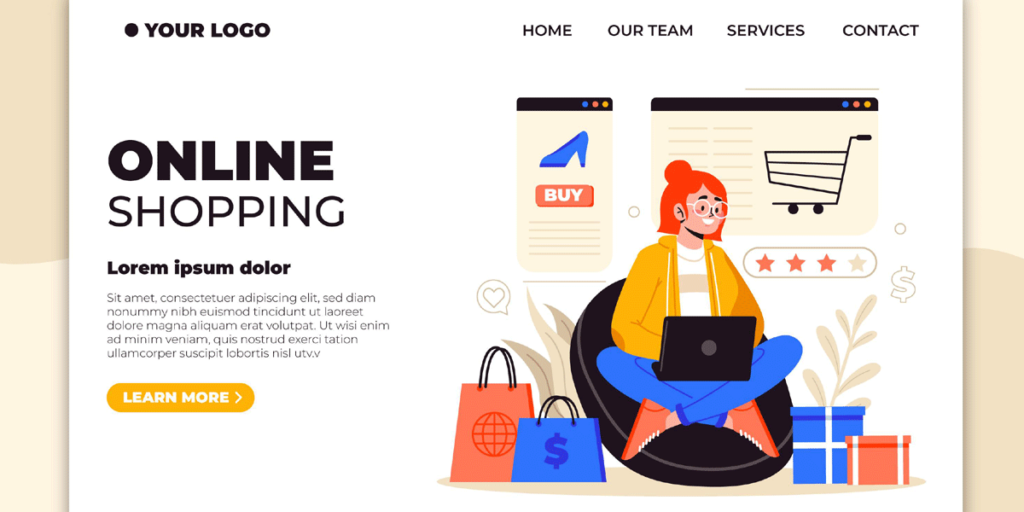In the world of ecommerce, the landing page is a critical component of any successful online business. It serves as the gateway to your website, the first impression that potential customers have of your brand. A well-designed and optimized landing page can make all the difference in converting visitors into paying customers. In this article, we will explore the key elements and best practices for creating the perfect ecommerce landing page that converts, along with some real-world examples to inspire you.
Define Your Goal:
Before diving into the design and content, it’s essential to define the goal of your landing page. Are you looking to drive sales, capture leads, or promote a specific product or service? Understanding your objective will guide the rest of the decision-making process.
Simplicity is Key:
When it comes to ecommerce landing pages, simplicity reigns supreme. A cluttered page can confuse and overwhelm visitors, leading them to bounce before taking any action. Keep your design clean, with a clear hierarchy of information and a focused call-to-action (CTA) that guides visitors toward the desired action.
Clear and Compelling Headline:
Capture visitors’ attention with a clear and compelling headline that immediately communicates the value proposition of your product or service. It should be concise, benefit-oriented, and address a specific pain point or desire of your target audience.
Example: “Revolutionize Your Fitness Routine with Our Innovative Smartwatch Tracker.”
Engaging Visuals:
Humans are visual creatures, and high-quality visuals can significantly impact the success of your landing page. Use images or videos that showcase your product from different angles or demonstrate it in action. Make sure the visuals are relevant, professional, and load quickly to avoid frustrating users.
Example: Apple’s landing page for the iPhone features stunning product images and videos that highlight its sleek design and advanced features.
Compelling Copy:
Your landing page copy should be persuasive, concise, and customer-centric. Focus on the benefits and unique selling points of your product or service. Use compelling language that resonates with your target audience and motivates them to take action.
Example: Nike’s landing page for running shoes uses strong, action-oriented language to inspire visitors and convey the superior performance and comfort of their products.
Strong Call-to-Action (CTA):
Your CTA is the most critical element of your landing page. Make it stand out visually, using contrasting colors and placing it strategically on the page. Use action verbs and create a sense of urgency to encourage visitors to take the desired action, such as “Buy Now,” “Sign Up,” or “Get Started.”
Example: Amazon’s landing page for Prime membership prominently displays a “Start your 30-day free trial” CTA, encouraging visitors to sign up for their service.
Social Proof and Trust Signals:
Building trust with your visitors is crucial for conversions. Incorporate social proof elements such as customer reviews, testimonials, ratings, or trust badges to instil confidence in your product or service. These elements validate your claims and help alleviate any doubts or concerns visitors may have.
Example: Airbnb’s landing page includes ratings and reviews from previous guests, giving potential customers confidence in the quality and trustworthiness of their listings.
Mobile Optimization:
With the rise of mobile browsing, it is essential to ensure that your landing page is fully optimized for mobile devices. Make sure your page loads quickly, the text is legible, and the layout is responsive. Test your landing page across various devices and screen sizes to deliver a seamless experience to all users.
Example: Google’s landing page for its Pixel smartphone is fully optimized for mobile, providing a smooth browsing and purchasing experience on smaller screens.
A/B Testing and Optimization:
Creating the perfect ecommerce landing page is an ongoing process. Conduct A/B tests to compare different variations of your page and identify the elements that perform best. Test different headlines, CTAs, visuals, or layout options to continuously improve your conversion rates.
Example: Shopify, a leading ecommerce platform, regularly tests different landing page variations to optimize their conversion rates. They experiment with different design elements, copy variations, and CTA placements to identify the most effective combination.
Analyze and Iterate:
Monitor the performance of your landing page using web analytics tools. Track key metrics such as bounce rate, conversion rate, time on page, and click-through rate to evaluate its effectiveness. Use the insights gained to make data-driven decisions and continuously refine your landing page to maximize conversions.
Example: HubSpot, a marketing software company, uses analytics tools to track and analyze the performance of its landing pages. They gather insights on user behavior and engagement to improve their conversion rates.
By following these best practices and incorporating the examples mentioned above, you can create a highly effective ecommerce landing page that converts visitors into loyal customers. Remember, optimization is an ongoing process, so continuously analyze, test, and refine your landing page to stay ahead of the competition and achieve your business goals.
You may also like
-
Web Development Company in Chandigarh: Your Gateway to Digital Success
-
Best Cleaning Company in Dubai: How to Choose the Right One
-
Elevate Your Online Presence with Expert Web Design & Development Services
-
Where You Find Printer Rental in Dubai for Your Needs
-
ECommerce Website Development Services That Grow Your Brand

